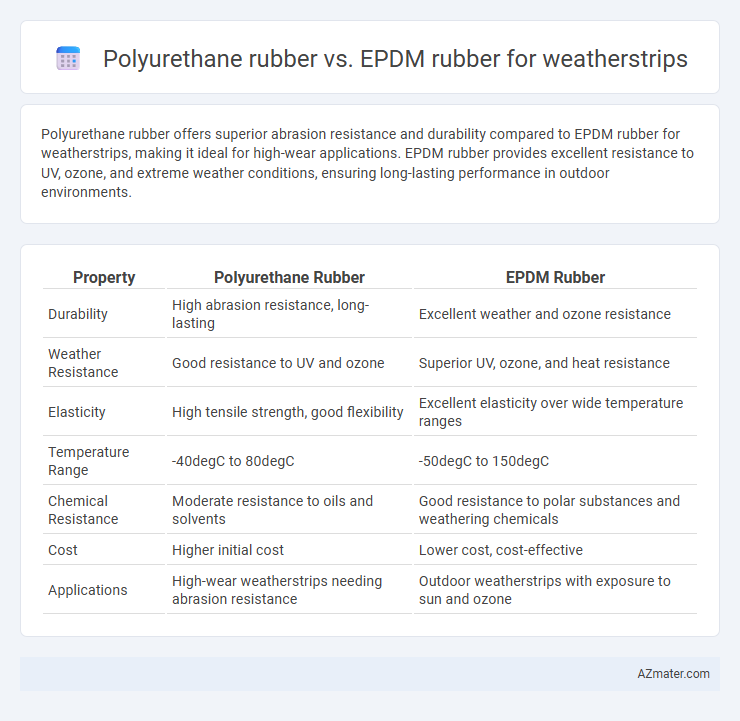Polyurethane rubber offers superior abrasion resistance and durability compared to EPDM rubber for weatherstrips, making it ideal for high-wear applications. EPDM rubber provides excellent resistance to UV, ozone, and extreme weather conditions, ensuring long-lasting performance in outdoor environments.
Table of Comparison
| Property | Polyurethane Rubber | EPDM Rubber |
|---|---|---|
| Durability | High abrasion resistance, long-lasting | Excellent weather and ozone resistance |
| Weather Resistance | Good resistance to UV and ozone | Superior UV, ozone, and heat resistance |
| Elasticity | High tensile strength, good flexibility | Excellent elasticity over wide temperature ranges |
| Temperature Range | -40degC to 80degC | -50degC to 150degC |
| Chemical Resistance | Moderate resistance to oils and solvents | Good resistance to polar substances and weathering chemicals |
| Cost | Higher initial cost | Lower cost, cost-effective |
| Applications | High-wear weatherstrips needing abrasion resistance | Outdoor weatherstrips with exposure to sun and ozone |
Introduction to Weatherstripping Materials
Polyurethane rubber and EPDM rubber are two primary materials used in weatherstripping, each offering distinct properties for sealing applications. Polyurethane rubber is known for its excellent abrasion resistance, high tensile strength, and superior elasticity, making it ideal for dynamic environments requiring durability. EPDM rubber excels in UV, ozone, and extreme weather resistance, providing long-lasting performance in outdoor sealing applications exposed to harsh environmental conditions.
Overview of Polyurethane Rubber
Polyurethane rubber offers superior abrasion resistance and excellent tensile strength compared to EPDM rubber, making it a preferred choice for weatherstripping applications requiring durability and flexibility. Its chemical composition provides resistance to oils, solvents, and environmental factors such as ozone and UV radiation, ensuring long-lasting performance in various weather conditions. Polyurethane rubber's ability to maintain elasticity over a wide temperature range enhances its effectiveness in sealing and insulation tasks.
Overview of EPDM Rubber
EPDM rubber, a synthetic elastomer, is highly resistant to weathering, ozone, UV rays, and extreme temperatures, making it ideal for weatherstrip applications. Its excellent flexibility and durability ensure a long service life in automotive seals and window gaskets. Compared to polyurethane rubber, EPDM offers superior performance in outdoor environments due to its enhanced resistance to heat and environmental factors.
Key Properties Comparison: Polyurethane vs. EPDM
Polyurethane rubber offers superior abrasion resistance and tensile strength compared to EPDM rubber, making it ideal for high-wear weatherstrip applications. EPDM excels in UV resistance, ozone resistance, and weatherability, ensuring long-term durability in outdoor environments. Both materials provide excellent flexibility and sealing properties, but polyurethane is preferred for mechanical durability while EPDM is favored for environmental exposure.
Weather Resistance and Durability
Polyurethane rubber offers superior abrasion resistance and excellent durability under harsh environmental conditions compared to EPDM rubber, making it ideal for weatherstrip applications requiring long-lasting performance. EPDM rubber excels in UV, ozone, and extreme temperature resistance, providing excellent weather resistance and flexibility in varying climates. For weatherstrips, polyurethane ensures higher tensile strength and wear resistance, while EPDM delivers better resilience against environmental aging and chemical exposure.
Flexibility and Mechanical Performance
Polyurethane rubber offers superior mechanical performance with high tensile strength, excellent abrasion resistance, and good flexibility, making it ideal for weatherstrips exposed to harsh conditions. EPDM rubber provides exceptional flexibility and outstanding resistance to UV radiation, ozone, and extreme temperatures, ensuring long-lasting sealing performance in outdoor applications. Polyurethane excels in durability under mechanical stress, while EPDM is preferred for weatherstrips requiring sustained elasticity in variable climates.
Chemical and UV Resistance
Polyurethane rubber offers superior abrasion resistance and excellent chemical resistance to oils, solvents, and fuels, making it ideal for weatherstripping in harsh environments. EPDM rubber provides outstanding UV, ozone, and weather resistance, maintaining elasticity and performance under prolonged sun exposure and extreme temperatures. Choosing between them depends on the specific environmental stresses, with EPDM preferred for UV and weather durability, while polyurethane excels in chemical exposure scenarios.
Cost and Installation Considerations
Polyurethane rubber offers higher durability and abrasion resistance for weatherstripping but comes at a higher initial cost compared to EPDM rubber, which is more budget-friendly and provides excellent resistance to UV rays and ozone. Installation of polyurethane weatherstrips may require specialized adhesives and tools due to its tougher material properties, while EPDM rubber allows for easier cutting and bonding with standard adhesives, reducing labor time. Considering long-term expenses, EPDM's flexibility and simpler installation can lower overall project costs despite its shorter lifespan relative to polyurethane.
Common Applications in Weatherstripping
Polyurethane rubber and EPDM rubber are widely used in weatherstripping due to their excellent sealing properties and durability. Polyurethane rubber is favored for applications requiring high abrasion resistance and load-bearing capacity, such as industrial and automotive weatherstrips exposed to extreme mechanical stress. EPDM rubber excels in outdoor weatherstripping for doors and windows, offering superior resistance to UV rays, ozone, and temperature variations, making it ideal for sealing against air and water infiltration.
Choosing the Right Rubber for Your Project
Polyurethane rubber offers superior abrasion resistance and elasticity, making it ideal for weatherstripping applications exposed to intense wear and tear. EPDM rubber excels in resisting UV rays, ozone, and extreme weather conditions, ensuring long-lasting performance in outdoor environments. Selecting the right rubber depends on the specific project requirements, with polyurethane preferred for durability and EPDM chosen for environmental resilience.

Infographic: Polyurethane rubber vs EPDM rubber for Weatherstrip
 azmater.com
azmater.com